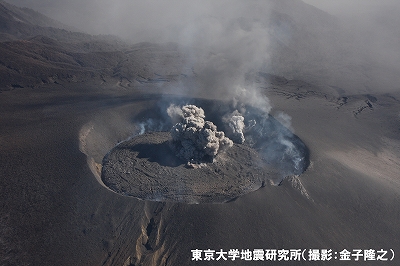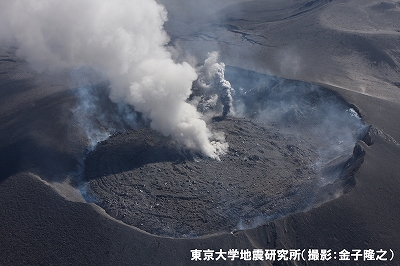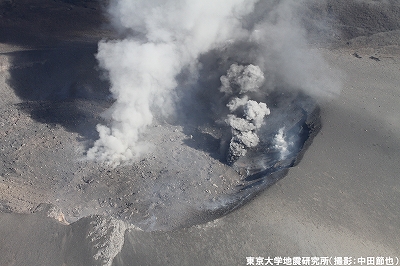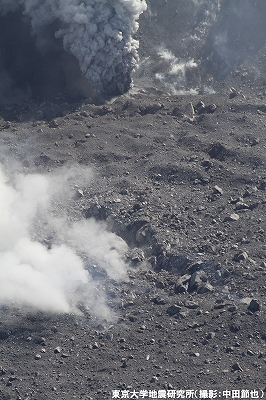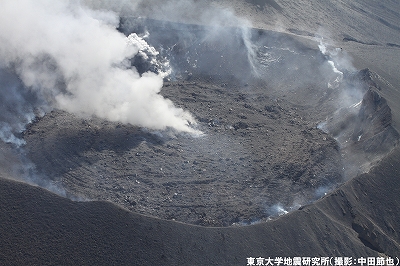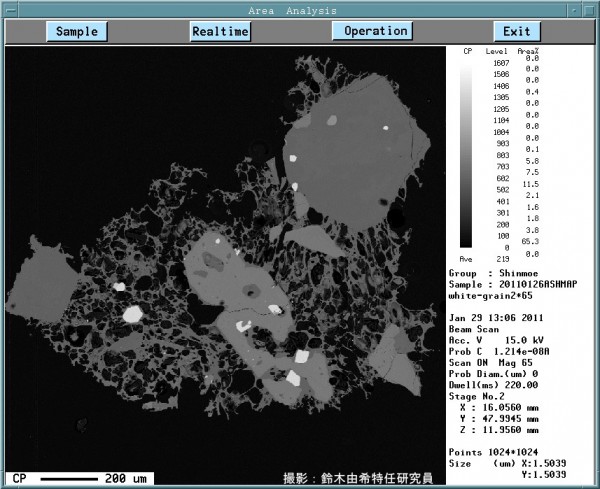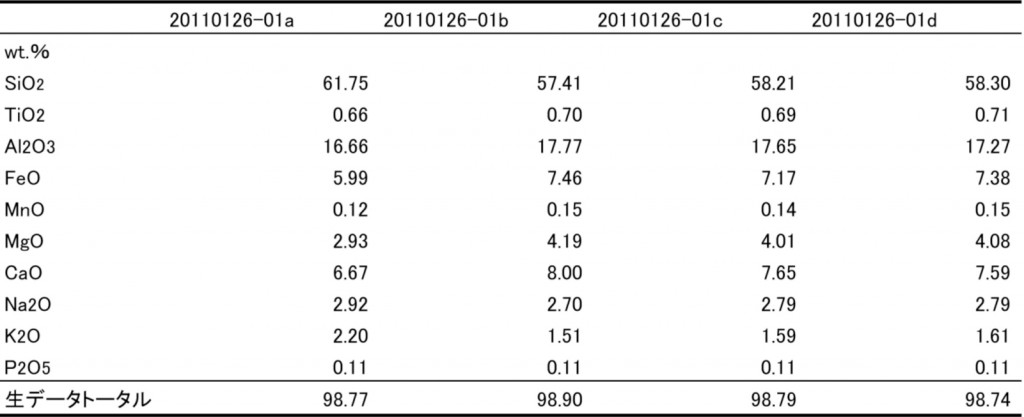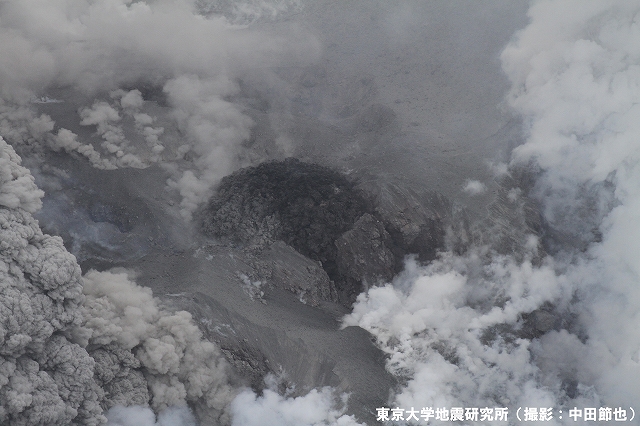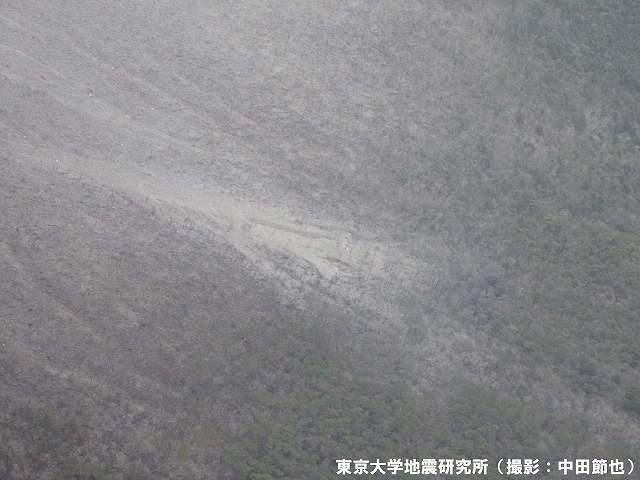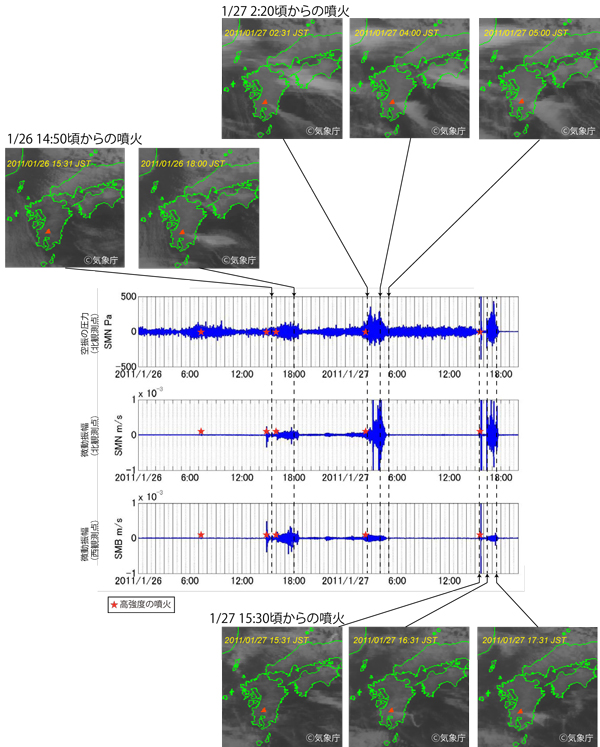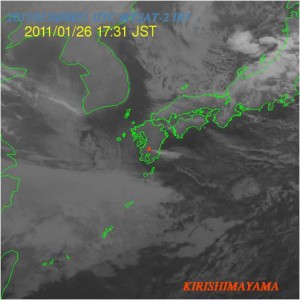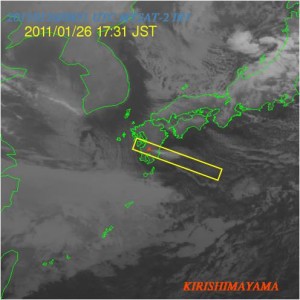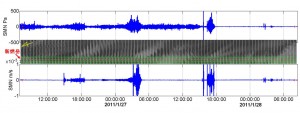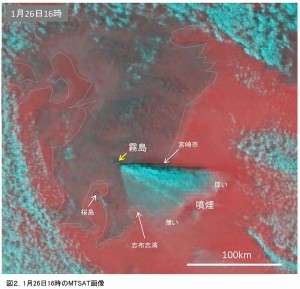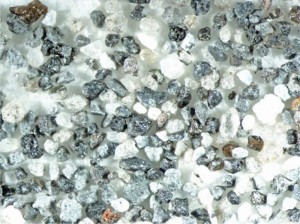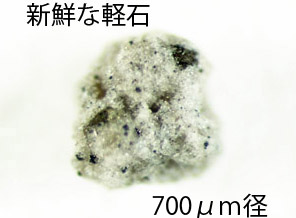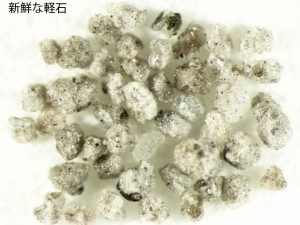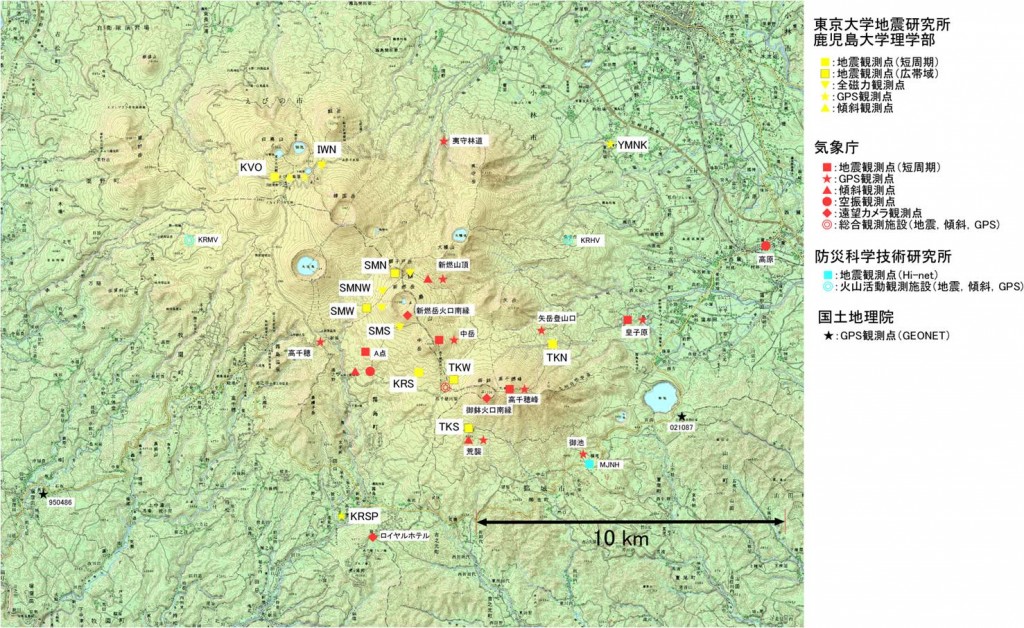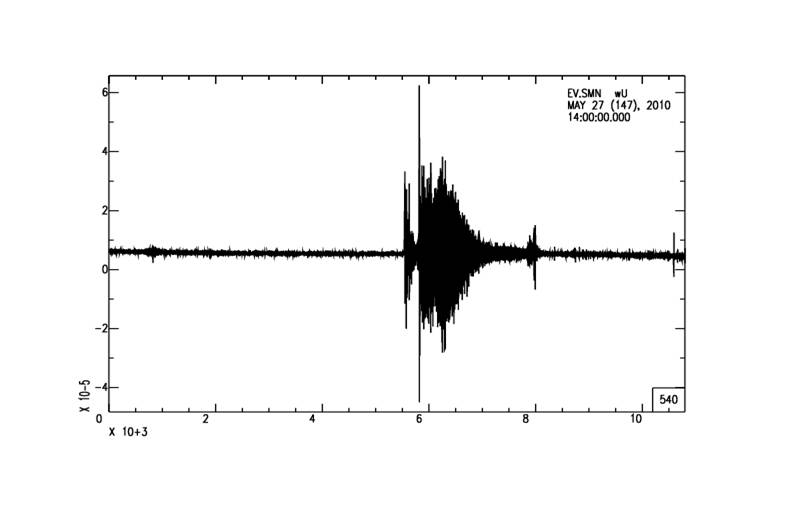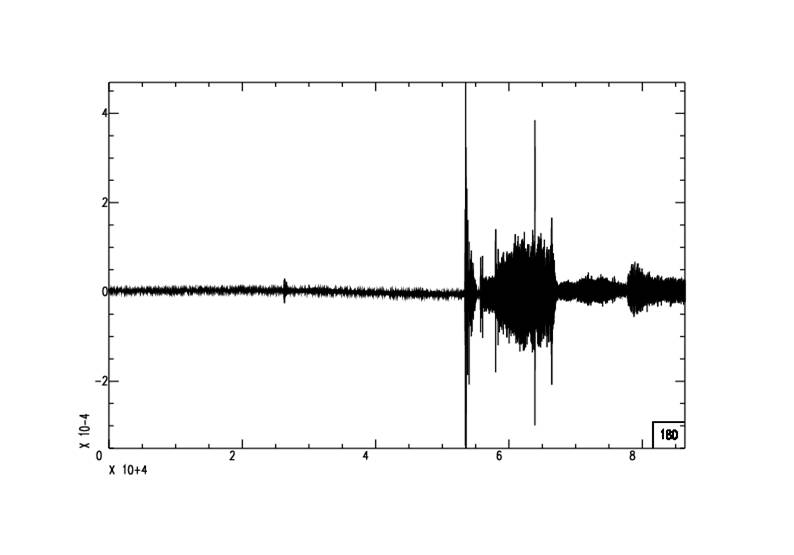Launched on: January 27, 2011
Last updated on: 22nd February
Shinmoe-dake erupted on 19th January, following a small eruption on 26th. According to the Japan Meteorological Agency, a gray ash plume rose up to 1500m above crater rim around 15:30(JST). VAAC(Volcanic Ash Advisory Center) reported it once reached 7500m. By 18:00(JST) the Volcanic Alert Level is raised to level 3.
[Updates]
- Pictures of the crater (4th February)
- Juvenile material found in the eruption on 26th January
- Press conference held on 31st January
- The chemical composition of the whole-rock found in eruption products from Shinmoe-dake (Kirishima volcano)
- Pictures of the crater
- Synchronicity of the eruption captured by : satellite image, infrasonic wave data, and tremor data
- The waveforms of the volcanic tremors
- Infrasonic Wave caused by eruption
- Microscope observation result of volcanic ash on 19th January
- The eruption of Shinmoe-dake captured by MTSAT
- About Shinmoe-dake
- Eruption History
- Links
[Pictures of the crater (taken on 4th February)]
Image credit: Earthquake Research Institute, Univ.Tokyo (photo by: Setsuya NAKADA) Earthquake Research Institute, Univ.Tokyo (photo by: Takayuki KANEKO)
[Fresh magmatic material found in the eruption on 26th January]—The two types of magma: low and high temperature magma, involved in an eruption.
Variation diagram of the whole-rock chemical composition
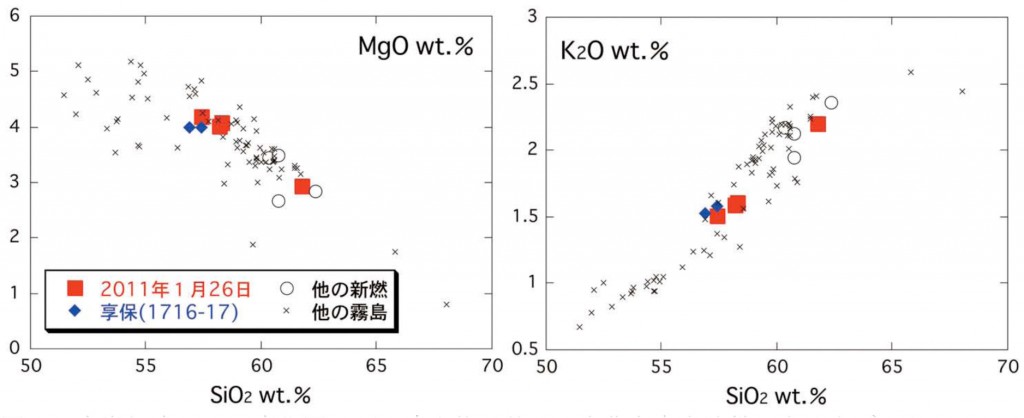
Fig.3 The SiO2 variation diagram of the whole-rock chemical composition. The data except for the eruption product on 26th January are undisclosed data from assistant prof. Miyamoto in Tohoku University.
Groundmass glass composition
Chemical composition of groundmass was analyzed to investigate if the difference of whole-rock composition is due to the difference in melt composition of magma. In the white-colored parts of pumice, groundmass consists of only glass, no matter if shape and color of pumice. On the other hand, microlites are recognized in the groundmass of the gray- and brown-colored parts (fig.4). This observation indicates that a portion of melt was crystallized to produce the amount of microlite. Despite this crystallization, the gray- and brown-colored parts seem undifferentiated compared to the white-colored one (fig.4), as characterized by SiO2-poor and MgO-rich in its composition (fig.5).
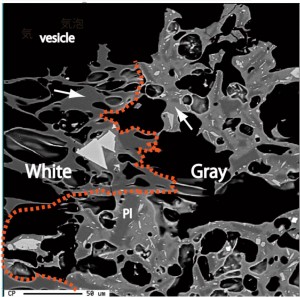
Fig.4 Groundmass glass composition of the border between white and gray part of the banded pumice. The microlite of the gray part are: plagioclase (pl), pyroxene, Fe-Ti oxide (from darkest to the light). The glasses (indicated by arrows) are lighter and less undifferentiated in gray than in white.
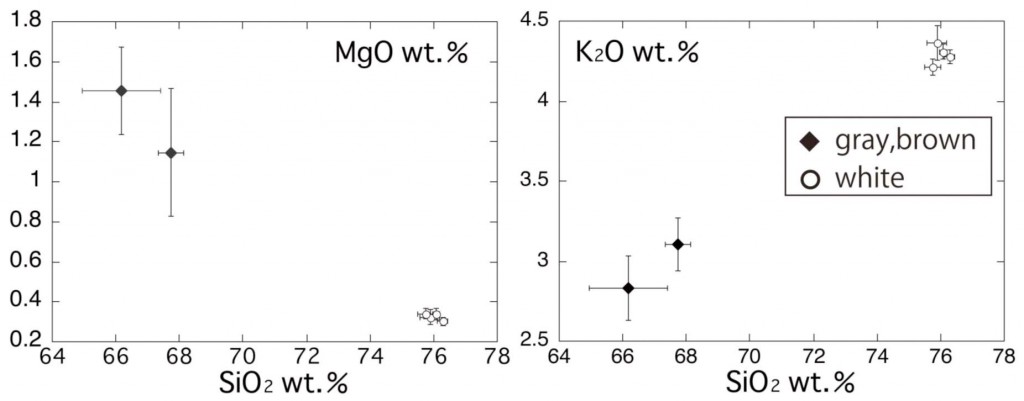
Fig5. The SiO2 variation diagram of the glass composition. A single plot is an average of 1 particle of pumice. 10points on the white part, 5points on the gray and brown part are analyzed by each particle. The error bar is 1-sigma in this measurement. Each color includes the white, gray/brown part of the banded pumice.
Phenocryst assemblage and equilibrium relation.
According to observation of ash particles, phenocryst of clinopyroxene, orthopyroxene, plagioclase, and Fe-Ti oxide are contained in all colored (white, brown, gray) pumice. Meanwhile, olivine exists only in brown and gray parts. Based on phenocryst composition, pyroxene and olivine should be non-equilibrium. Therefore, the reason why brown- or gray-colored pumice is undifferentiated both in whole-rock and groundmass composition compare to the white pumice could be due to a mixing of two different types of magma with different temperatures. The low temperature magma could produce white-colored pumice including phenocryst of pyroxene, plagioclase, and Fe-Ti oxide. The high temperature magma includes olivine phenocryst at least at the time of 26th January. It mixed with low temperature magma and erupted.
(Researcher.Yuki Suzuki and Associate prof. Atsushi Yasuda)
Ashes
- Collected date and time: Wednesday 26th January, 2011. 19:30
- Collected place: 3km toward Miyazaki on Route 10, from Miyakonojo interchange.
- Collected by: Emeritus Professor Junichi Hirabayashi in Tokyo Institute of Technology.
Ash treatment and specimen sorting: the greatest radius of the ash particle is 5mm. After placing the ashes inside an ultrasound bath with pure water, decant off the supernatant liquid, screening out the remained particle and filtered Juvenile material from above 1mm. Pumice has variation of colors: white, brown, gray and even some are banded pumice having all three colors mixed (fig.2)
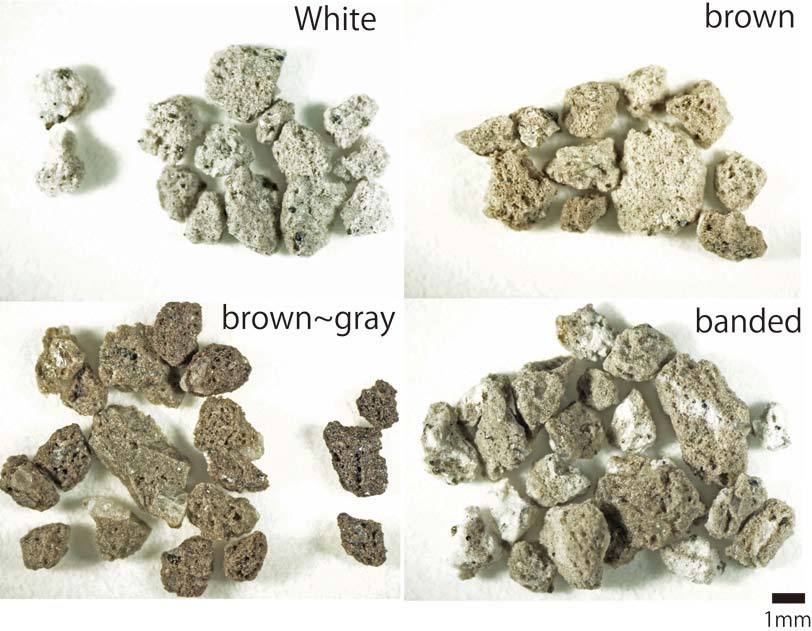
Fig.2 The juvenile material (pumice particle) of the ash found on 26th. The numbers of the particle shown here do not always indicate the rate according to the ash.
An image of the frothed juvenile material
Below is an enlarged image of the frothed juvenile material (white pumice in above image). The whole piece is about 1mm. The black part in the image is frothed part. The parts with no bubbles are the phenocrysts. Because of the frothing, they become spiky and this leads to causing damages such as scratching the glass window. (Picture taken by : researcher Yuki SUZUKI)
[Press conference held on 31st January]
Below is the list of media reports (the list is according to internet research and listed in random order) :
47News
FNN
TBS News-i
Jiji Press Co
Nippon TV News24
Nikkei
The Chugoku Shimbun
Nishinippon Shimbun
Asahi.com (in English)
The Mainichi Daily News (in English)
Daily Yomiuri Online (in English)
Eruption History (according to historical records)
- 1716-17: A major activity is recorded. The activity changed its style with time from phreatic to phreatomagmatic explosion, and then to magma eruption. We can tell from deposit characteristics as that the eruption repeatedly occurred with pumice eruption, base surges, pyroclastic flows, and mud flows.
- 1771-72: Starting with either phreatic explosion or phreatomagmatic explosion, it caused pyroclastic flows. It is assumed that wildfire occurred by hot pyroclastic fallouts.
- 1822: Starting from either phreatic explosion or phreatomagmatic explosion, with some mud flows, pumice fallouts. Pyroclastic flows may have occurred on the western slope.
- 1959: phreatic explosion
- 1991: minor eruption after noticeable earthquake activity
- 2008: minor eruption. (Website of the eruption in 2008-only in Jpanese)
Referrence:
Imura, R. and Kobayashi, T. (2001) Geological map of Kirishima Volcano (1:50,000), Geological Survey of Japan.
Imura, R. and Kobayashi, T. (1991) Eruptions of Shinmoedake Volcano, Kirishima Volcano Group, in the Last 300 Years, Bulletin of the Volcanological Society of Japan, 36, 135-148.
[Whole rock chemical composition of eruption products from Shinmoe-dake (Kirishima volcano)]
Juvenile pumice erupted from Shinmoe-dake on 26thwas analysed. SiO2 content of the whole-rock is in a range of 57.4-61.8 wt.%. This data indicates that the ongoing eruptive activity is caused by andesitic magma.
( Associate prof. Atsushi Yasuda, Researcher.Yuki Suzuki, Technical staff. Natsumi Hokanishi)
Ashes
[Results of chemical analysis]
Below is a list of major element compositions, which is adjusted to make the total weight percentage to 100. The raw data is shown in the bottom row. The SiO2 amount of white pumice (20110126-01a) is higher than other samples by 3wt.%. It suggests that the ejected magma has a variety in composition.
[Images of the crater (taken on 28th)]
Below are selected aerial photos of erupting crater taken on 28th morning.
Image credit: Earthquake Research Institute, Univ.Tokyo (photo by: Setsuya NAKADA)
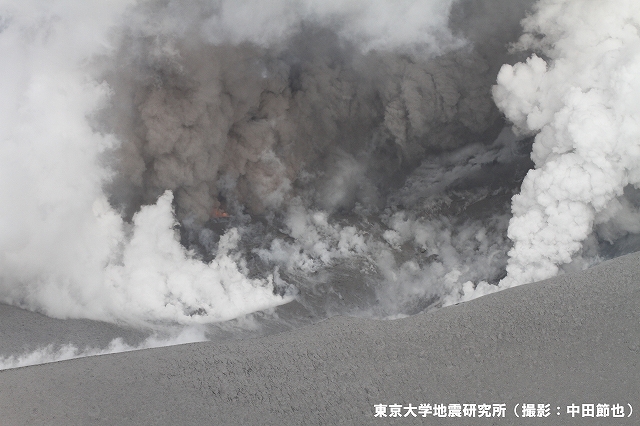
Southern part of the crater bottom. Taken from southwest. In the middle is a lava dome, and a red-colored spot is recognized behind it.
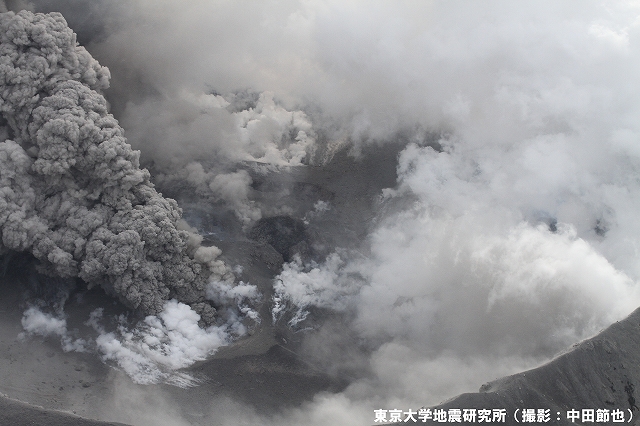
Central part of crater bottom, taken from northwest. A black leaf-like shape in the middle is the lava dome.
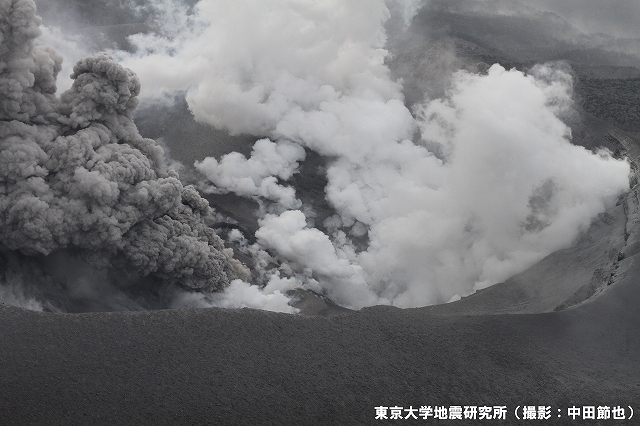
Taken from the north. A huge crater is recognized on the right side of the central crater. White smokes also rising.
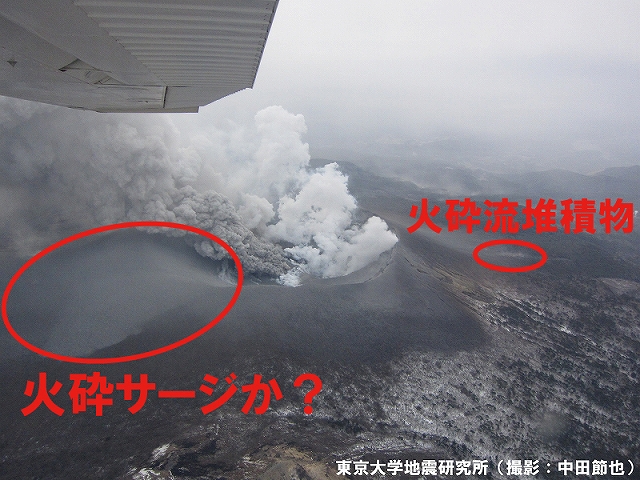
Image taken from the north. Left side: surge-like deposit on outside crater. Right side: white-colored pyroclastic flow deposit which covers the ash deposit area.
[Synchronicity of the eruption captured by : satellite image, infrasonic wave data, and tremor data]
Shinmoe-dake of Kirishima volcano is continuously ejecting ash plume since 26th January. These high intensity eruptions are not only witnessed but also captured by remote video cameras 3 times: 14:50-18:30(JST) on 26th January, 2:20-4:50 on 27th January and 15:30-17:30 27th on January. We can see that the amplitude of tremor had become larger between 14:50-18:30 on 26th, 2:20-4:50 on 27th, and 15:30-17:30 on 27th January, and that the amplitude of the infrasonic wave became larger corresponding with the increase of tremor activity. Just before and after these activities, ash plume is not obvious on the infrared images taken by satellite of Japan Meteorological Agency. But 1-2 hours after that, ash plume widely spreading toward east can be clearly recognized. That is, it can explain that the intensity of eruption became higher as the amplitude of tremor and infrasonic wave became large. This will be one of indicators of volcanic activity of this time.
Click the image below to see a movie of ash plume.
Yellow rectangular area was clipped (left figure), and ordering in time (right figure). They were compared with seismic and infrasonic wave data collected at SMN (the observation station on the North of Shinmoe-dake). (click to enlarge the image)
Satellite image and animation credit: Japan Meteorological Agency
*Because the satellite is capturing as it moves, the mentioned time has a margin of error about 10minutes.
According to “Geological map of Kirishima Volcano”, Kirishima Volcano is a generic name for Quaternary volcanoes located in Southern Kyushu, around the border between prefectures of Kagoshima and Miyazaki. There are about 20 volcanoes including the highest peak of Karakunidake and other volcanoes such as Takachihonomine. Shinmoe-dake is one of the active volcanoes among them.
Historical documents indicate that there was a major eruptive activity of the volcano in 1716 to 1717. The eruption changed its style from phreatic to phreatomagmatic explosion and then to magmatic eruption. In 1959 there was a phreatic explosion, and then a minor eruption occurred in 1991 after notable earthquakes. There was also some minor eruption in August 2008. (the eruption in 2008- only in Japanese)
Referrence: Imura, R. and Kobayashi, T. (2001) Geological map of Kirishima Volcano (1:50,000), Geological Survey of Japan.
[The eruption of Shinmoe-dake captured by MTSAT]
Kirishima volcano erupted again on 26th January, after the minor eruptions in 19th January 2011. By the observation of ash plume by MTSAT, the eruption on 26th was confirmed that it was an eruption with an unprecedented scale. A minor eruption began from 07:30 (JST) on 26th, and images taken with MTSAT, shows ash plume extending toward southeast (fig:1, 13:00,14:00). A bigger scale ash plume can be seen on the 15:00 image. This ash plume extends toward east to southeast, and by 16:00, passing over Miyazaki city and reached to Hyuganada. As a whole, the ash plume is to be extending out in a sector form.
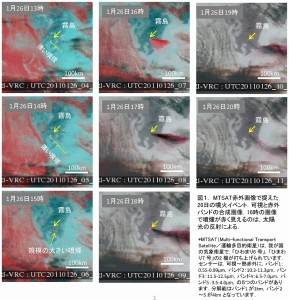
Fig1:Eruption on 26th captured by MTSAT infrared imagery. It is a composite image of visible and infrared band. The reason why ash plume looks red in the image of 16:00(JST) is because of the reflection of the sunlight.
Figure2 is an enlarged picture of the image from 16:00(JST). This image explains that ash plume is thick in the north and is thinning toward south. The ash plume extending in sector form is considered to be caused by the difference of direction of the wind according to the altitude (in this case having south as low altitude). By the condition of ash plume, the axis of volcanic ash fall could be estimated as directly east of Kirishima, which is toward south of Miyazaki city. Additionally, the south edge seems to have reached Shibushiwan. Image of 17:00 shows the expansion of ash plume and the leading end is reaching 150km east above sea level of Miyazaki city. The ash plume is extending thinly toward south as well, and its leading end is reaching almost up to Osumi-hanto. The image of 18:00 in figure 1 shows a huge geothermal anomaly (this was captured at night and is not affected by sunlight) at the summit area of Kirishima volcano. It is assumed as the eruption rate of ash plume being high. According to the images of 19:00 and 20:00, the ejection of ash plume is gradually decreasing.
[What is MTSAT?]
Multi-Functional Transport Satellites, Himawari6 and Himawari7 is a geostationary satellites owned and operated by Japan. The sensor contains invisible/ thermal infrared 5bands : Band1: 0.55‐0.99μm, Band2:10.3‐11.3μm, Band3:11.5‐12.5μm, Band4:6.5‐7.0μm, Band 5:3.5‐4.0μm
(By Satellite Data Monitoring Group of East Asia Active Volcanoes: assistant prof. Takayuki Kaneko, associate prof. Atsushi Yasuda, researcher. Hiroyuki Den et al. cooperates: Mr.Takasaki)
[Microscope observation result of volcanic ash on 19th January]–Relatively huge amount of juvenile material was detected before the eruption on 26th January.
Sample of volcanic ash ejected from Shinmoe-dake by the eruption on 19th January, was observed with microscope between 24th and 25th January (reported to Japan Meteorological Agency on 26th). As a result, the volcanic ash is characterized by the same components as ashes from 3 former eruptions: August 2008, March 2010 and May 2010. However, 8% of pumice that could be considered as an essential material (fresh magmatic rock) was newly found in coarse-grained particles.
- Pumice(8%): Categorized in to 2types according to if it is transmutable or not.
- A fresh type: taking up 95% of the pumice, and is observed for the first time since August 2008. This fresh pumice contains pyroxene and plagioclase phenocryst. The groundmass is clear glass and contains fine Fe-Ti oxide. This glass is foam formation and contains many undeformable bubbles. Therefore the surface of pumice shows no sharpness that occurs when torn, but has a bubble like round shape. Because the glass is fresh and clear with no adherence of altered substance, the possibility of juvenile material is very high. This pumice may also exists in a grain diameter of 500~1000µm.
- Transmutable type: Pumice with brownish-red color and contains finer bubble than above fresh pumice, and cervine pumice with big bubble was found.
- Scoria(4%): vesicularity is higher than pumice. A white substance adhere inside and outside of the bubble, and also a grain with almost fully glassy luster that has no adhere of altered substance also exists, other than the round grains on the surface. The percentages of grain with glassy luster among scoria are about 20%.
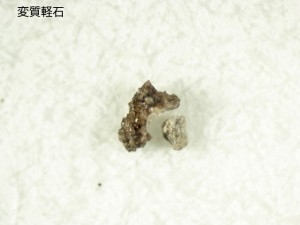
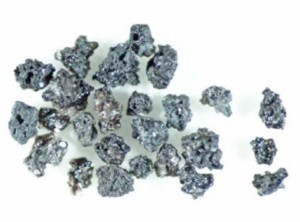
- Altered lava (22%): a white/orange colored lava which is considered being silicified. On silicified lava, a pyrite adheres partially or even entirely. The silicified pumice and scoria are also included.
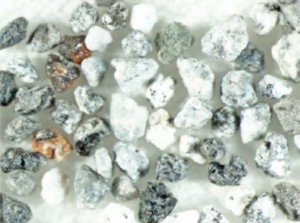
- Non-altered lava(48%): Less or non-transmutable lava compare to Altered lava. Mostly grey, black, or brownish-red and the groundmass crystallinity varies. The roundness of grain is less than Altered lava.
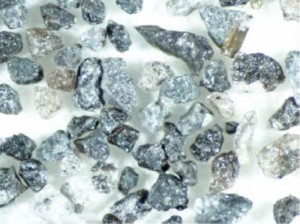
- Crystal (18%): An extricated crystal of plagioclase, clinopyroxene, orthopyroxene, and Fe-Ti oxide product.
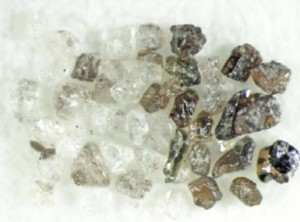
Comparison of the constituent particle of volcanic ashes ejected after the eruption 2008.
Below figure shows the rate of constituent particle of volcanic ashes of the past three eruptions and the eruption on January 19th. Although the constituent particle of the past three eruptions and the eruption this time are similar, it is distinctive that the amount of pumice is increasing to 8% which used to be 1to 2%. This increase corresponds to the bubble like pumice that was observed for the first time.
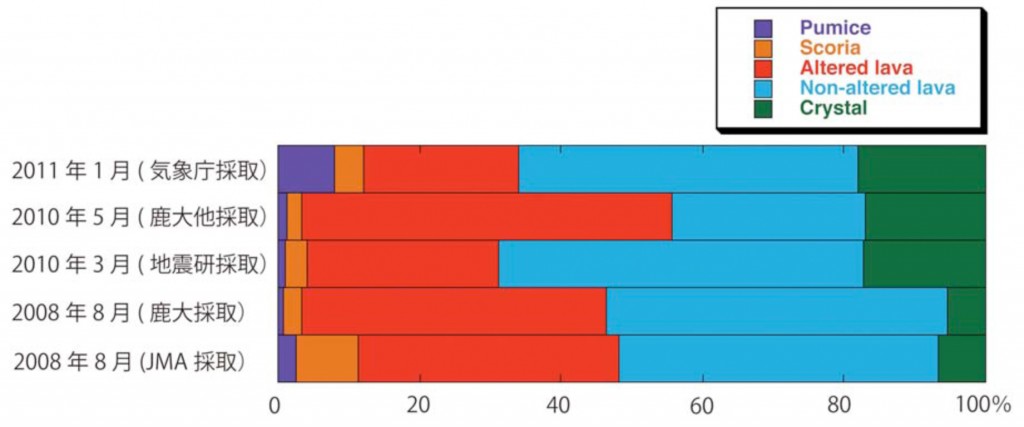
January 2011(Collected by Japan Meteorological Agency) May 2010(Collected by Kagoshima University et al.) March 2010(Collected by Earthquake Research Institute) August 2010(Collected by Kagoshima University) August 2008(Collected by JMA)
(By: Researcher. Yuki Suzuki)
[Infrasonic Wave caused by eruption]
Some people may have spent a terrifying night hearing the windows rattling at home. This is called “infrasonic wave” and is a phenomena which the compressed air travels as an acoustic wave. This infrasonic wave occurs also when a jet airplane lands or takes off, or even when a space shuttle makes re-entry to the aerosphere.
Research of the eruption using this infrasonic is going on as well. It is useful especially under whiteout condition such as during eruption. The observed infrasonic waves of the eruption this time is as follows:
Infrasonic wave analysis of the eruption of Shinmoe-dake
It is reproduced to be audible by fast-forwarding the low frequency wave of the recorded infrasonic wave. The sound of the eruption is audible.
The sound of Kirishima eruption 2011
(By: Assistant prof. Mie Ichihara)
[The waveforms of the volcanic tremors]
Instruments such as: seismograph, total magnetometer, GPS, tiltmeter and infrasonic wave vibrograph have been settled in Kirishima area.
The figures below are the velocity waveforms observed at SMN, a seismometer located in the north of Shinmoe-dake. Left figure is the one recorded on May 27th 2010 and the right figure, January 26th 2011, respectively. We can see the tremors as the background and the large amplitude corresponding to the eruption.
The amplitude of the left figure is scaled 10 times larger, which indicates that the scale of the eruption this time is about 10 times larger than that in May 2010.
Figure below is the comparison of SMN and SMW located in the west. The change in amplitude between 02:00 to 04:00(JST) on 27th January suggests that the origin of the tremor has moved toward north.
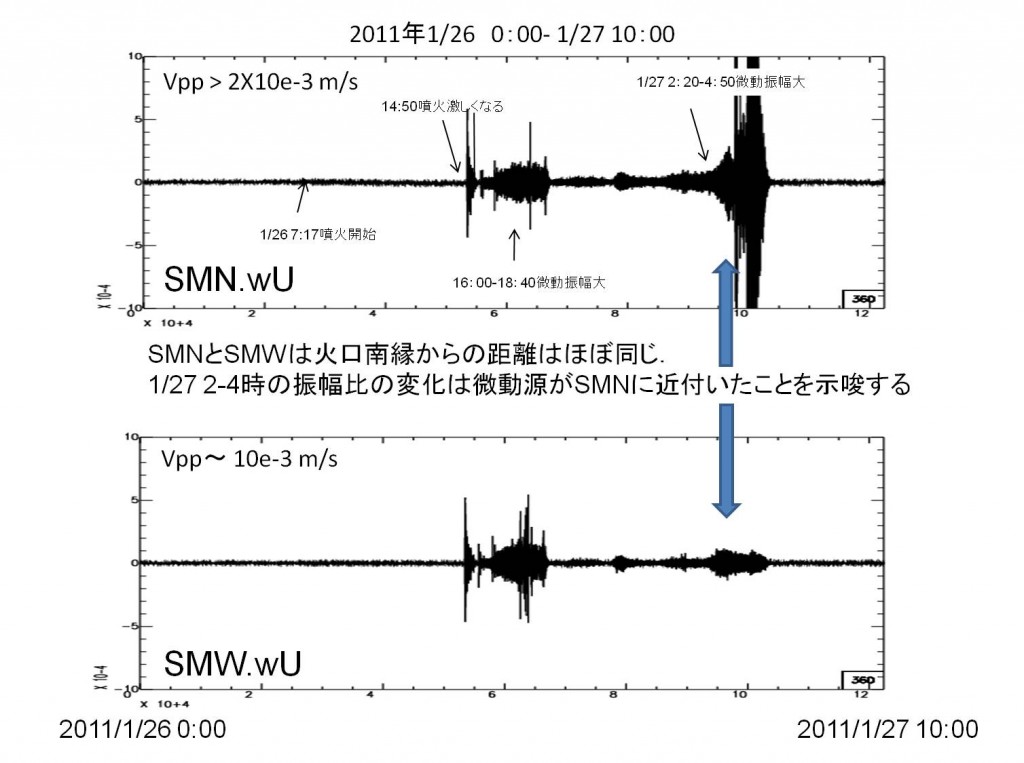
Both SMN and SMW are in same distance from the south edge of the crater. The change in amplitude ratio on 27th January 02:00 to 04:00(JST), suggest that the origin of the tremor has moved toward SMN.
- Japan Meteorological Agency:http://www.jma.go.jp/jma/indexe.html
- Surveillance image of Kirishima Volcano: http://kirishima-live.jpn.org/
- Smithsonian :http://www.volcano.si.edu/reports/usgs/#kirishim
- Kirishima volcano surveillance image: http://kirishima-live.jpn.org/
- National Research Institute for Earth Science and Disaster and Prevention:http://www.bosai.go.jp/e/index.html
For basic information about volcanoes:
January 27, 2011
Shinmoe-dake that erupted in small scale on 19th January, erupted again on 26th. According to the Japan Meteorological Agency, an ash gray ash plume rose up to 7500m above crater rim around 15:30. By 18:00 the Volcanic Alert Level is raised to level 3.
*(Updates)*
About Shinmoe-dake.
According to “Kirishima Volcanic Geological map”, Kirishima Volcano is a generic term for quaternary volcanoes, located in Southern Kyushu, around the border between prefectures of Kagoshima and Miyazaki. There are about 20 volcanoes including the highest peak Karakunidake and other volcanoes such as Takachihonomine. Shinmoedake is one of the active volcanos among them.
The eruption recorded in the historical material shows that there was a major activity of volcano in 1716 to 1717. The eruption changed its style from phreatic explosion to phreatomagmatic explosion and then to magmatic eruption. In 1959 there was a phreatic explosion, and then minor eruption occurred in 1991 after notable earthquakes. There was also some minor eruption in August 2008. (Eruption in 2008)
Referrence: Kousuke Imura, Tetsuo Kobayashi: Kirishima Volcanic Geological map, Geological Survey of Japan,2001.
The eruption of Shinmoedake captured by MTSAT
Kirishima volcano erupted again on 26th January, after the minor eruptions in 19th January 2010. By the observation of ash plume by MTSAT, the eruption on 26th was confirmed that it was an eruption with an unprecedented scale. A minor eruption began from 7:30 on 26th, and images taken with MTSAT, shows ash plume extending toward southeast (fig:1, 13:00,14:00). A bigger scale ash plume can be seen on the 15:00 image. This ash plume extends toward east to southeast, and by 16:00, passing over Miyazaki city and reached to Hyuganada. As a whole, the ash plume is to be extending out in a sector form.
Figure2 is an enlarged picture of the image from 16:00. This image explains that ash plume is thick in the north and is thinning toward south. The ash plume extending in sector form is considered to be caused by the difference of direction of the wind according to the altitude (in this case having south as low altitude). By the condition of ash plume, the axis of volcanic ash fall could be estimated as directly east of Kirishima, which is toward south of Miyazaki city. Additionally, the south edge seems to have reached Shibushiwan. Image of 17:00 shows the expansion of ash plume and the leading end is reaching 150km east above sea level of Miyazaki city. The ash plume is extending thinly toward south as well, and its leading end is reaching almost up to Osumi-hanto. The image of 18:00 in figure 1 shows a huge geothermal anomaly (this was captured at night and is not affected by sunlight) at the summit area of Kirishima volcano. It is assumed as the eruption rate of ash plume being high. According to the images of 19:00 and 20:00, the ejection of ash plume is gradually decreasing.

